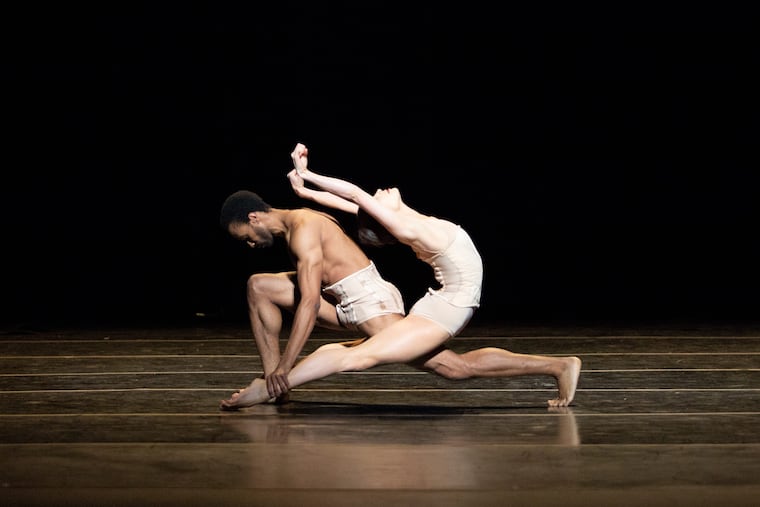Pennsylvania Ballet ‘Petite Mort’ program puts the company’s distinct mark on modern
The program is a theme and variations, with Jiří Kylián's Petite Mort as theme and two world-premiere variations from Andrea Miller and company dancer Russell Ducker.

The Pennsylvania Ballet opened its November program at the Merriam Theater Thursday night with a theme and variations on the classic leotard ballet.
On mostly flat shoes and with recorded music, the series of three modern ballets — two of them new works — is something BalletX might have danced. But there's room for both, and the Pennsylvania Ballet's larger cast gives a rich, layered look on stage that complements rather than competes with its peers across Broad Street.
The theme in the program is Jiří Kylián's Petite Mort, which has become a favorite with many companies. The Pennsylvania Ballet last danced it in 2014 as part of the company's 50th anniversary celebration. The variations are two world premieres: Andrea Miller's Evenings, and This Divide by Pennsylvania Ballet corps de ballet dancer Russell Ducker.
It's easy to see why Petite Mort has become so popular. Created in 1991 for the Salzburg Festival to mark the second century of Mozart's death, it is set to two favorite piano concertos (Nos. 21 and 23). The dancers are in sleek beige barely there costumes. Six men wield fencing foils, slicing them audibly through the air, rolling them in arcs along the floor, lifting them with their toes.
A huge cloth is pulled over the stage and dancers, allowing for a quick change of scene. Six women move in and out of the backdrop, sometimes nearly floating across the stage.
Petite Mort features three strong, gorgeous pas de deux. My favorite Thursday was from Lillian DiPiazza and Jermel Johnson, shaping their bodies into seemingly impossible positions.
Petite Mort is a sexual ballet — the swords, the nearly naked bodies, the very name (petite mort means "small death," or orgasm). But it's by no means overt; you'll see what you want to see.
They run and jump over and over, and then take positions we can just barely make out, arms and legs reaching out from sculptural bodies.
The dancers sprint across the stage, giving us just quick glimpses. A trio of duets appears in one spotlight after another, revealing a taste of the full dancer.
Audiences generally go to the ballet to see the dancers. But you don't need to see every detail to appreciate the beautiful shapes of a piece, and Miller's Evenings makes that point well.
Darkness into light is such a common theme in choreography that it's a cliché, but this new work is so lovely the template can be forgiven.
Ducker made This Divide to the music of Glenn Branca, an avant-garde composer born in Harrisburg who died in May. The music is a soundscape as much as a score for the ballet, another modern piece danced in minimal costume.
It opens with a huge staircase on wheels and a dancer striking a pose at the top. From there, the dancers move on, around, and through the structure, running into its underbelly or crouching in the cupboard under the stairs.
Ducker's first work for the Pennsylvania Ballet is ambitious but also busy. The large structure is so imposing the humans often get lost. The focus turns to the dancers pushing it across the stage rather than the ones dancing difficult steps. Solos are lost in the shadows while the light is focused on the stairs.
I'm interested to see what Ducker will do next. More clarity on stage would help provide a better sense of his style.
DANCE REVIEW
Pennsylvania Ballet, 'Petite Mort' and world premieres
Through Sunday at the Merriam Theater, 250 S. Broad St. Tickets: $35-$154. Information: 215-893-1999 or paballet.org.